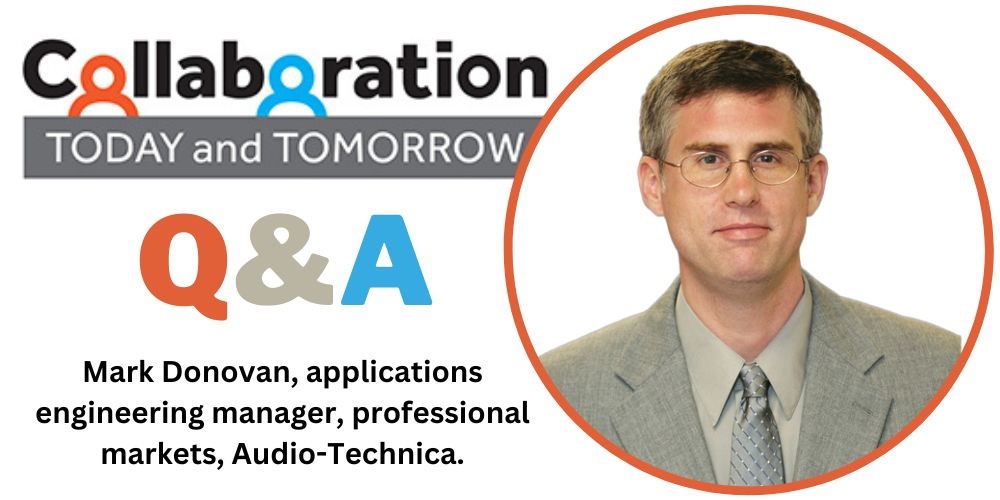Collaboration Today and Tomorrow: How do you see collaboration evolving these days?
Mark Donovan: It’s interesting because “collaboration” is somewhat of a more recent term. In the last few years, it’s become kind of a buzzword. But, at the end of the day, it’s really about getting people to work together seamlessly. And I think that the whole COVID-19 thing kind of forced everybody’s hands a little bit more. Because we were all forced to be physically apart, yet still try to get that seamless communication…that seamless interaction. And so, from all the manufacturers — whether you’re talking about audio, such as Audio-Technica, or video and things like that — it’s become more important to simplify that.
If I go back 10 years, a collaboration space tended to be a fairly complex piece of equipment. Not just for installation but also for the end users. You had to have some fairly specialized knowledge of how to use this particular piece or that particular piece. And, again, what has happened now, as we’ve moved forward, is all the manufacturers have been forced to remove a lot of those barriers so that there’s less of a problem for these end users. They can very easily walk into a space, start a meeting on time and make things happen, instead of burning time trying to figure out the technology.
CT&T: How is Audio-Technica leaning into that drive for simplicity?
Donovan: From the simplicity side, we’re approaching it from two levels of simplicity — not just a single level. The first is the integrator that puts it in there. So, the integrator that’s going into Corporation XYZ, it’s all about how easy it’s going to be to put it in there [and] how quickly they can do it, so that they can be more efficient, so they can do more rooms [and] so their corporation can be more profitable. That’s the one level of simplicity, and we focus very heavily on trying to save the integrator time and effort when putting our products in and setting them up.
And then, at the same time, we do have those customer-facing portions of our products, whether it’s a software interface, or web-browser based, or whether it’s just the actual physical controls themselves. We try to simplify that. The whole thing is, buttons aren’t toys. The reality is, although some of us tech people love to have buttons everywhere, it’s not as good to have them all over the place for an end user that just doesn’t have the time or inclination to figure out which of these buttons to press. So, we just kind of make it all very simple to deal with. So, we’re approaching it from both directions.
CT&T: How does A-T leverage its reputation for excellent quality when collaboration experiences cannot be subpar?
Donovan: I actually think this is a great crossroads, bringing all of this together from the quality. On the one side, again, if we’re going back 10 or 15 years ago — even 20 years ago — audio quality was one of those things where it’s like, “Ehhh… if I can hear a person, that’s fine.” People were used to cell phones. People were used to early, really highly compressed MP3s. And that was fine…then. But now, as we move forward, and computers are faster and storage is cheaper and streaming speeds are faster, we get that better audio quality. People are really focused on video quality as we move in these higher resolutions, and the audio has to match that.
Audio-Technica, from its very roots, 60 years ago, started from the whole concept of providing high-quality audio to the masses, as it were. Back in our beginning days with turntables. And it’s something where we’ve brought that ear to every product since 1962. We’re going to put a critical ear on all of this because we want the best possible audio quality. And then, as these two have now merged, what you end up with — and what I think puts us in the lead in a lot of these aspects — is this: The quality of the audio is one of the things that I think people sometimes overlook in a collaboration space. Yes, it’s important for music and recording and things like that. But, at the end of the day, this quality equals intelligibility.
You’re sitting on the far side of a call; you’re trying to collaborate with a really complicated project; you’ve been in this project meeting for the last three hours. Poor-quality audio will just crush your senses to the point that you just can’t focus anymore because you’re trying to focus through this hash of noise. And our approach has always been give you the best quality of audio possible. Preserve that voice…preserve that sound…so that you’re not fighting to hear through other things.
And, so, I think that’s really key to making collaboration spaces work. Video, obviously, has come a long way. Now, we’re fine-tuning the audio, and I think Audio-Technica’s in the perfect place to make that happen now.
For more Collaboration Today and Tomorrow content, check out our website archives.










